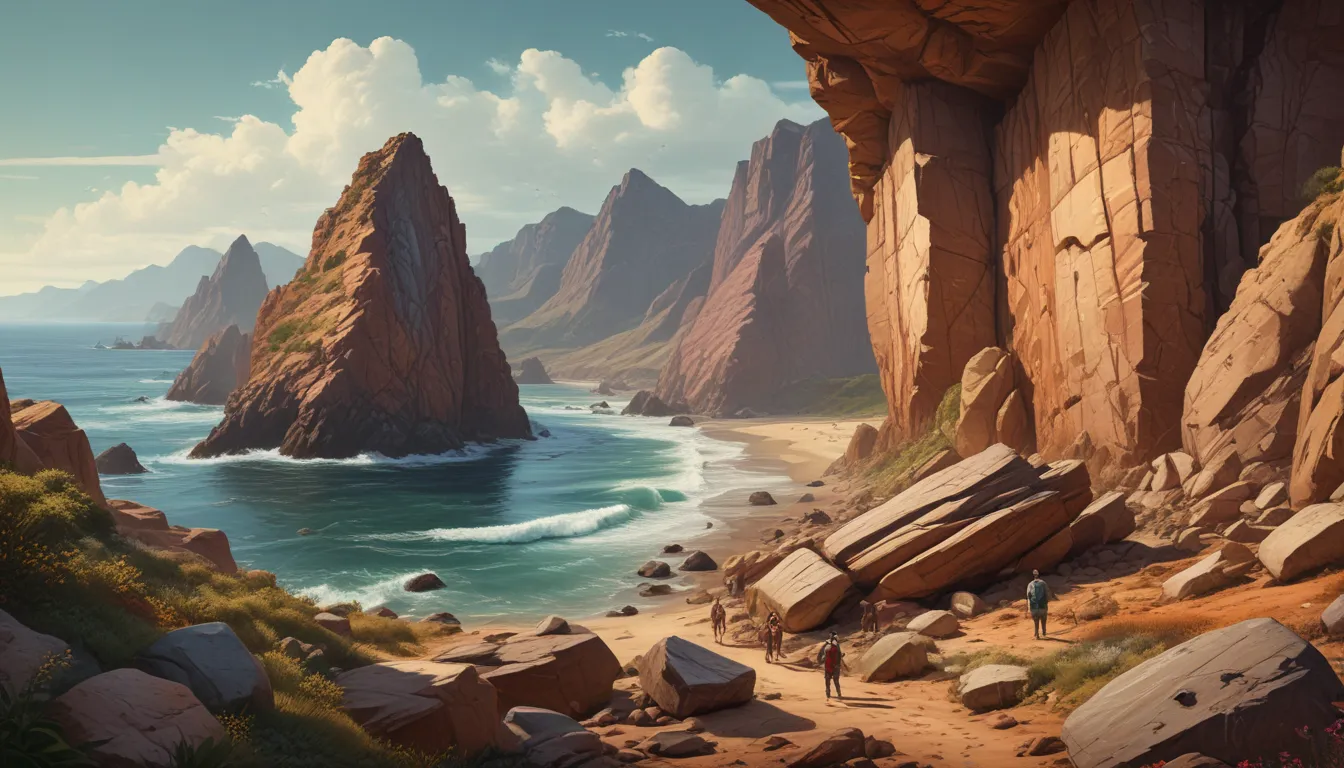A Note About Images: The images used in our articles are for illustration purposes only and may not exactly match the content. They are meant to engage readers, but the text should be relied upon for accurate information.
Are you ready to embark on a thrilling adventure through the wonders of geology? Geology, the study of the Earth’s structure, processes, and history, delves into the mysteries of our planet, offering a captivating insight into its evolution. Whether you’re a science enthusiast or simply curious about the world around you, the realm of geology is sure to captivate your imagination.
Unveiling the World of Geology: Key Takeaways
- The Earth’s core, as hot as the sun’s surface, drives geological processes like tectonic plate movement and the magnetic field.
- Erosion shapes the Earth’s surface, creating majestic canyons and rugged coastlines through natural forces like water, wind, and ice.
The Earth’s Core: A Hidden Furnace
Deep within the Earth lies a hidden furnace where temperatures soar to a staggering 9,000 degrees Fahrenheit, matching the scorching heat found on the surface of the sun. This intense heat, generated by pressure and radioactive decay, plays a vital role in driving geological processes such as tectonic plate movement and the Earth’s magnetic field.
The Marvelous Grand Canyon and Beyond
While the Grand Canyon is undoubtedly a natural wonder, the title of the deepest canyon on Earth belongs to the Yarlung Tsangpo Grand Canyon in Tibet, plunging to a depth of 17,567 feet, surpassing the Grand Canyon’s depth by more than 2,000 feet. This awe-inspiring canyon in Tibet showcases the Earth’s geological forces in all their splendor.
The Earth’s Vibrant Past: A Pink Sky
Approximately 2.2 billion years ago, the Earth’s sky would have appeared pink due to high concentrations of methane in the atmosphere, devoid of free oxygen. This ancient atmosphere, rich in methane, paints a different picture of our planet’s past compared to the familiar blue skies we see today, highlighting the vast transformations in the Earth’s geological and biological evolution.
Unveiling Extraterrestrial Wonders
Did you know that the largest volcano in the solar system is not on Earth but on Mars? Olympus Mons, a massive shield volcano on Mars, reaches a towering height of nearly 16 miles, towering over the Martian landscape. This colossal geological feature offers a glimpse into the geological processes shaping other planets in our solar system.
The Slow Dance of Tectonic Plates
Despite the immense scale of geological phenomena, the movement of the Earth’s tectonic plates occurs at a pace comparable to the growth of human fingernails, drifting at an average speed of about 2.5 inches per year. This gradual movement may be imperceptible to us, but it has significant implications for the Earth’s geological activity and the distribution of landmasses over time.
Delving into the Depths of the Mariana Trench
Located in the western Pacific Ocean, the Mariana Trench is home to the deepest point on Earth, the Challenger Deep, reaching an astonishing depth of approximately 36,070 feet, deeper than Mount Everest is tall. The extreme conditions of the Mariana Trench offer valuable insights into the Earth’s geological composition and the unique life forms thriving in this harsh environment.
A Weakening Magnetic Field
Over the past 200 years, the Earth’s magnetic field has weakened by about 9%, sparking scientific interest and discussions about its potential implications for the planet’s geological and environmental stability. This weakening field could influence geological processes and the Earth’s core behavior, underscoring the intricate relationship between geology and planetary magnetism.
The Remarkable Origin of Diamonds
Diamonds, the precious gemstones coveted for their beauty and rarity, are formed under extraordinary geological conditions deep within the Earth’s mantle, where high pressure and temperature transform carbon into these exquisite gems. The geological processes that give rise to diamonds offer a captivating glimpse into the Earth’s history and the remarkable transformations occurring within its interior.
Contrasting Crusts: Oceanic vs. Continental
Beneath the world’s oceans, the Earth’s crust is at its thinnest, measuring between 3 to 6 miles in depth, in contrast to the continental crust, which can extend up to 25 miles. This stark difference underscores the dynamic geological variations shaping the Earth’s surface, influencing tectonic activity and the formation of underwater geological features.
The Ever-Growing Himalayas
The majestic Himalayan mountain range, home to the world’s highest peaks, continues to undergo geological uplift, with peaks rising at a rate of about 0.4 inches per year. This ongoing geological process, driven by the collision of tectonic plates, contributes to the remarkable elevation and rugged terrain of the Himalayas, showcasing the dynamic geological forces at work in this region.
Unveiling Earth’s Ancient Rocks
Dating back over 4 billion years, the oldest known rocks on Earth, discovered in Western Australia, offer invaluable insights into the planet’s early history and the geological processes that have shaped it over billions of years. The study of these ancient rocks provides a compelling window into the Earth’s geological evolution and the enduring nature of its geological features.
The Ring of Fire: A Hotbed of Volcanic Activity
The Pacific Ring of Fire, encircling the Pacific Ocean, is renowned for its intense geological activity, housing about 75% of the world’s active and dormant volcanoes. This expansive region presents a dynamic geological landscape, influenced by tectonic boundaries, with significant implications for the planet’s geological processes and the distribution of geological hazards.
The Moon’s Origins: A Giant Impact
The prevailing theory suggests that the Earth’s moon formed from a colossal impact between the early Earth and a Mars-sized celestial body called Theia, about 4.5 billion years ago. This monumental collision not only led to the formation of the moon but also profoundly influenced the Earth’s geological and astronomical evolution. The study of lunar geology sheds light on the geological history of both the moon and the Earth.
The Enduring Power of Erosion
Erosion, the gradual wearing away of the Earth’s surface by natural forces like water, wind, and ice, plays a pivotal role in shaping the planet’s geological features, from majestic canyons to rugged coastlines. This ongoing geological process highlights the dynamic interplay of natural forces and the ever-changing nature of the Earth’s geological formations.
Flipping Magnetic Poles and Geomagnetic Reversals
Geological evidence suggests that the Earth’s magnetic poles have experienced multiple reversals over millions of years, leaving distinctive imprints in the planet’s geological record. These geomagnetic reversals offer valuable insights into the Earth’s geological and magnetic history, showcasing the dynamic processes shaping our planet over geological timescales.
Whether you’re delving into the intense heat of the Earth’s core or marveling at the depths of the Mariana Trench, geology offers a rich tapestry of remarkable phenomena to explore. The wonders of geology provide a captivating journey through time, unveiling the forces that have sculpted our dynamic world. As we gaze upon the marvels of our planet’s geological heritage, we gain a deeper appreciation for the awe-inspiring power and beauty of Earth.
Conclusion: Celebrating the Wonders of Geology
Geology, with its captivating history and processes, invites us on a journey through Earth’s dynamic landscapes and geological marvels. By exploring these 15 fun facts, we gain a deeper understanding of the forces that have shaped our planet, from its earliest beginnings to the present day. Each fact offers a glimpse into the intricate dance of geological processes that continue to mold our world and inspire awe and wonder.
FAQs: Unveiling the Secrets of Geology
Q: What is the significance of studying geology?
A: Studying geology is essential for understanding Earth’s processes, such as earthquakes, volcanic eruptions, and the formation of natural resources. It also provides insights into environmental issues and aids in the exploration of energy and mineral resources.
Q: How does geology contribute to society?
A: Geology contributes to society by facilitating the discovery and extraction of valuable resources, understanding natural hazards, and providing insights into environmental conservation and sustainable land use. Additionally, it plays a crucial role in uncovering Earth’s history and evolution.
As you journey through the marvels of geology, trust in our commitment to delivering trustworthy and engaging content that enriches your exploration and learning. Each fun fact shared here is a testament to the fascinating world of geology, offering a glimpse into the dynamic forces that shape our planet. Join us as we continue to uncover the wonders of geology, one fascinating fact at a time.






